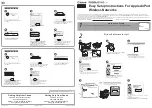
13 - 37
The
Root
tab displays the following:
The
Multicast Path
tab displays the following:
The
Neighbors
tab displays the following:
Sequence
The sequence number also known as the destination sequence number. It is updated
whenever a mesh point receives new information about the sequence number from RREQ,
RREP, or RERR messages that may be received related to that destination.
Mesh Point Name
Displays the name of each configured mesh point in the RF Domain.
Recommended
Displays the root that is recommended by the mesh routing layer.
Root MPID
The MP identifier is used to distinguish between other mesh points both on the same
device and on other devices. This is used by a user to setup the preferred root
configuration.
Next Hop IFID
The IFID of the next hop. The IFID is the MAC Address on the destination device.
Radio Interface
This indicates the interface that is used by the device to communicate with this neighbor.
The values are 2.4 and 5.0, indicating the frequency of the radio that is used to
communicate with the neighbor.
Bound
Indicates whether the root is bound or unbound.
Metric
Displays the computed path metric between the neighbor and their root mesh point.
Interface Bias
This field lists any bias applied because of Preferred Root Interface Index.
Neighbor Bias
This field lists any bias applied because of Preferred Root Next-Hop Neighbor IFID.
Root Bias
This field lists any bias applied because of Preferred Root MPID.
Mesh Point Name
Displays the name of each configured mesh point in the RF Domain.
Subscriber Name
The identifier is used to distinguish between other mesh points both on the same device
and on other devices. This is used by a user to setup the preferred root configuration.
Subscriber MPID
Lists the subscriber ID to distinguish between other mesh point neighbor devices in the
RF Domain.
Group Address
Displays the MAC address used for the group in the mesh point.
Timeout
The timeout interval in seconds. The interpretation of this value will vary depending on
the value of the state. If the state is Init or In Progress, the timeout duration has no
significance. If the state is Enabled, the timeout duration indicates the amount of time left
before the security validity check is initiated. If the state is Failed, the timeout duration is
the amount of time after which the system will retry.
Mesh Point Name
Displays the name of each configured mesh point in the RF Domain.
Destination Addr
Displays the MeshID (MAC Address) of each mesh point in the RF Domain.
Neighbor MP ID
The MAC Address that the device uses to define the mesh point in the device that the
neighbor is a part of. It is used to distinguish the device that is the neighbor.
Summary of Contents for WiNG 5.7.1
Page 1: ...WiNG 5 7 1 ACCESS POINT SYSTEM REFERENCE GUIDE ...
Page 2: ......
Page 3: ...WING 5 7 1 ACCESS POINT SYSTEM REFERENCE GUIDE MN001977A01 Revision A April 2015 ...
Page 4: ...ii WiNG 5 7 1 Access Point System Reference Guide ...
Page 24: ...1 4 WiNG 5 7 1 Access Point System Reference Guide ...
Page 36: ...2 12 WiNG 5 7 1 Access Point System Reference Guide ...
Page 72: ...3 36 WiNG 5 7 1 Access Point System Reference Guide ...
Page 470: ...5 386 WiNG 5 7 1 Access Point System Reference Guide ...
Page 472: ...6 2 WiNG 5 7 1 Access Point System Reference Guide Figure 6 1 Configuration Wireless menu ...
Page 624: ...7 46 WiNG 5 7 1 Access Point System Reference Guide ...
Page 724: ...9 56 WiNG 5 7 1 Access Point System Reference Guide ...
Page 783: ...12 35 Figure 12 46 Device Summary screen 4 Click File Management ...
Page 816: ...12 68 WiNG 5 7 1 Access Point System Reference Guide ...
Page 1006: ...13 190 WiNG 5 7 1 Access Point System Reference Guide ...
Page 1026: ...14 20 WiNG 5 7 1 Access Point System Reference Guide ...
Page 1028: ...A 2 WiNG 5 7 1 Access Point System Reference Guide ...
Page 1089: ......
Page 1090: ...MN001977A01 Revision A April 2015 ...
















































